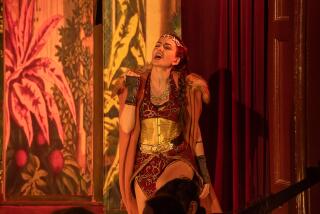Riot Grrrls of the Renaissance
- Share via
Babes, everywhere babes--as classical music, even early music, goes “Baywatch.”
On the high heels of the Eroica and Ahn trios, locked in publicity combat for the chamber group with the slinkiest gowns, and the provocative violinists Lara St. John and pouty teeny-bopper Vanessa-Mae, early music now has its sexy starlets.
Bimbetta, which has its first CD recently out on d’Note Classics and which appeared at UCLA’s Schoenberg Hall Sunday afternoon, advertises itself with the line, “Five babes go for Baroque.” A new British group, Mediaeval Baebes, with a CD of Gregorian chant soon to be out on Virgin, is made up of 12 self-described “lager-swilling, smoking, cursing, tattooed sex goddesses” who don’t read music but do go in for semi-nudity and a bit of witchcraft.
Compared with the Mediaeval Baebes’ raunchy premise, Bimbetta actually proved a bit tame Sunday. These women--three vocalists, a harpsichordist and cellist--happen to be exquisitely trained musicians with credible experience in professional early music ensembles and a highly cultivated sense of irony. All they want, apparently, is a little empowerment over dead white male composers.
So, attired in flashy modern street dress and with a studied sense of theatrical attitude, Bimbetta proudly turns the sexist tables (along with an occasional actual somersault). One example is Allison Zelles’ performance of the Purcell song “O let me weep!” The soprano first gives us Purcell’s sentiment straight, all longing sighs that her lover’s gone, gone. But the final “For I shall never see him more” is rendered pure triumph.
That early music is suitable for irony, humor and double-entendre is not, of course, news. Renaissance and Baroque composers often used those devises themselves. And P.D.Q. Bach, Peter Sellars and any number of postmodern choreographers have mined that particular territory long enough for it to verge on cliche.
In some ways, Bimbetta’s theatrics--the singers coyly bugalooing to Monteverdi or treating Purcell as torchy cabaret, sung with cigarette in hand--are a kind of Peter Sellars-lite. But in other ways, the act is just the opposite. Sellars uses such antics to break down barriers in the ultimate quest for self-knowledge. For Bimbetta, it’s all show. The group has baldly stated that its ambition is to get on MTV. And why not? It’s a novel, up-to-date act, and the music is good.
In fact, the real power of Bimbetta is in the performances. The two sopranos who performed, Zelles and Sonja Rasmussen, offered extraordinary fleet and sensitive singing. Both seem talented actresses (better than their material). Rasmussen also has a flair for contemporary folk and jazz styles. She added the very occasional blue note to a Purcell line and did so with taste and sophistication.
Zelles and Rasmussen also blend brilliantly. One duet, “Though I am young,” by Nicholas Lanier, was sung with spellbinding beauty, the voices circling each other, pulling in and out of unisons with heart-wrenching perfection. But equally typical of Bimbetta, it was accompanied by blatantly obvious hand movements.
Still, the music making generally was good enough to overcome the most sophomoric theatrics. Harpsichordist Katherine Shao and cellist Ann Marie Morgan offered solid, lively support and were each a delight in a few frilly Baroque instrumental pieces by Frescobaldi and Gabrielli.
The third soprano, Andrea Fullington, had a vocal ailment but was on hand to dance and clown. As nothing more than a glamorous presence, she proved just the kind of window dressing that hardly helped Bimbetta’s feminist image. But by not singing, she did, inadvertently, further substantiate the group’s musical accomplishment, since the instrumentalists proved capable enough vocalists to discreetly fill in.
More to Read
The biggest entertainment stories
Get our big stories about Hollywood, film, television, music, arts, culture and more right in your inbox as soon as they publish.
You may occasionally receive promotional content from the Los Angeles Times.










